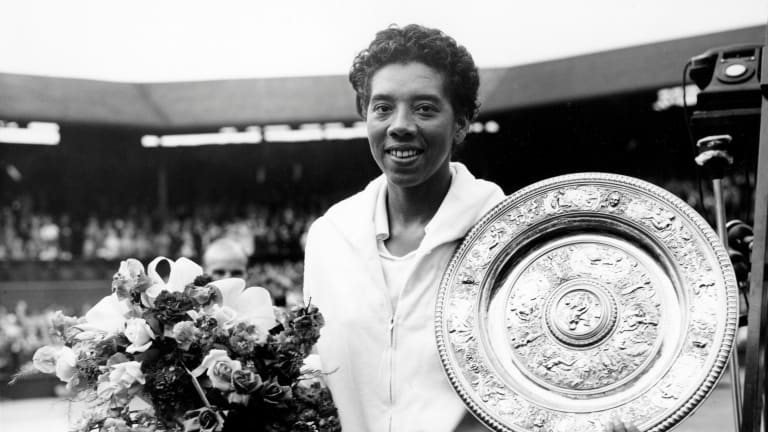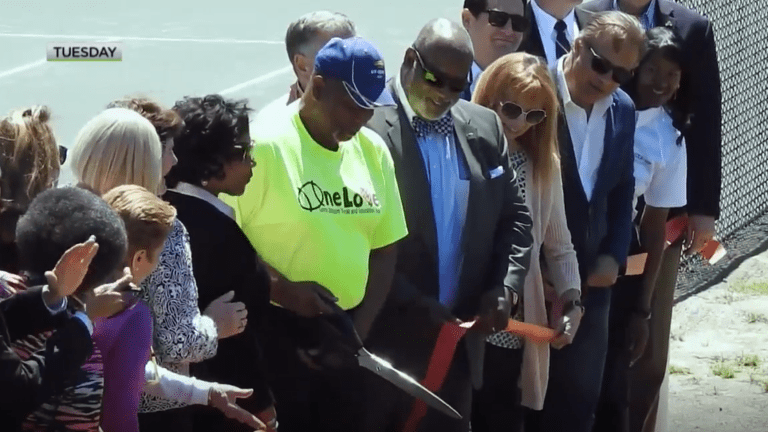If this court could talk: reviving a neglected piece of tennis history
By Steve Tignor Apr 29, 2019Madrid, Spain
China's Wang Xinyu saves 10 match points in first-round Madrid win over Viktoriya Tomova
By TENNIS.com Apr 24, 2024Pop Culture
Review: Plenty to be excited about in TopSpin 2K25, which successfully recreates the joy (and frustration) of tennis
By Stephanie Livaudais and Spencer Thordarson Apr 24, 2024Madrid, Spain
Fabian Marozsan saves 11 set points, wins pair of Madrid tie-breaks to defeat Aslan Karatsev
By TENNIS.com Apr 24, 2024Pop Culture
Coco Gauff dishes on 'embracing adulthood' in TIME magazine's May cover story
By Baseline Staff Apr 24, 2024Pick of the Day
Roberto Carballes Baena vs. Dominik Koepfer, Madrid
By Zachary Cohen Apr 24, 2024Madrid, Spain
Caroline Wozniacki stumbles in clay comeback, exits Madrid in nostalgic Errani match
By David Kane Apr 24, 2024Madrid, Spain
Rafael Nadal says he is not 100% fit ahead of Madrid debut and unsure about playing Roland Garros
By Associated Press Apr 24, 2024Line Calls
ATP Mutua Madrid Open Betting Preview
By Baseline Staff Apr 24, 2024Madrid, Spain
Despite jet lag, Sloane Stephens keeps winning in Madrid with big goals for clay swing
By David Kane Apr 24, 2024If this court could talk: reviving a neglected piece of tennis history
The revival of an historic court in North Carolina shines a spotlight on the civil-rights legacy of Althea Gibson’s mentor, Dr. Hubert Eaton.
Published Apr 29, 2019
Advertising
If the clay court at 1406 Orange Street could talk....Lenny Simpson knows exactly what it would say.
Two weeks ago, the 71-year-old Simpson presided over a re-opening ceremony, complete with ribbon cutting, for this backyard court in Wilmington, NC. At first glance, you might wonder why there would be so much fanfare over such a modest tennis facility, in a residential neighborhood, in a town that has never been known as a tennis hotbed. But Simpson, a former tour player who grew up on the same block in the 1950s, understands firsthand how significant this patch of clay is to the history of U.S. tennis.
“The whole property was immaculate, but I could only hear what was happening in the yard, I couldn’t see it,” Simpson says, describing his first encounter, as a 5-year-old, with the home of Dr. Hubert A. Eaton and his soon-to-be fabled backyard court. “Finally I peeped under the hedges, and it was like looking into a whole different world. There was a pool and a tennis court. Everyone was dressed in white, and they had wooden racquets, and they were playing this game. It was magical.”
But it was something else that made the 5-year-old Simpson’s eyes really pop out: “They were drinking Coca-Colas. I thought, ‘How can I get a Coca-Cola?’”
In those days, Simpson says, it was a “special privilege” for someone from the neighborhood to be invited into the home of Dr. Eaton, who was the chief surgeon at the African-American hospital in then-segregated Wilmington. When Simpson, who was determined to get his Coke, eventually found his way in, he was greeted with a smile by Dr. Eaton. But it was the words of the tall, lanky, young woman on the other side of the net that would stay with Simpson forever.
“She said, ‘Welcome, champ, to the court,’” Simpson says.
“I never forgot that. Here were all these other, older players, and I hadn’t even hit a ball. But she called me champ.”

If this court could talk: reviving a neglected piece of tennis history
© AFP/Getty Images
Advertising
It wasn’t just the word that meant something to him; it was the person who spoke it. This was Althea Gibson, the 25-year-old who had broken tennis’ color barrier in 1950 by becoming the first black player to enter the U.S. Nationals, and who would go on to become the first African-American to win at Roland Garros, Wimbledon and Forest Hills.
“There was an aura around Dr. Eaton and Althea when they walked out to the court,” Simpson remembers. “They were here to play, and everything had to be ready. I learned the game from them; they stood on either side of me and coached me while I hit against a backboard.”
Gibson had spent her youth in Harlem, but it probably wouldn’t be an exaggeration to say that she grew up, as a player and a young woman, while living and training at Dr. Eaton’s house in Wilmington.
The two met in 1946, at the American Tennis Association’s (ATA) national championships in Wilberforce, OH. The ATA was the sport’s African-American federation, but Eaton and his friend, Dr. Robert Johnson of Virginia, were looking for a young black player who might be able to integrate the sport, the way Jackie Robinson was in the process of integrating Major League Baseball.
Watching the teenage Gibson compete in the ATA women’s final, they thought they might have found their pioneer. She was all arms and legs, she was wildly inconsistent, and she didn’t know much about tennis tactics, but she was among the most talented athletes they had ever seen. So, as journalist Doug Smith wrote in his book about Johnson, Whirlwind, the two doctors “collaborated on a prescription.”
Knowing that Gibson would struggle to improve without better coaching and guidance, Eaton proposed a plan: He would house her at his home at 1406 Orange Street during the school year, while Johnson would house her at his home in Lynchburg, VA—where he had also built a court—during the summer.
“Who wouldn’t be interested in a deal like that?” Gibson said when Eaton and Johnson made their proposal after the match.
“If it weren’t for Dr. Eaton and [his wife] Celeste,” Lenny Simpson says, “there would be no Althea.”
Advertising
As one of Gibson’s biographers, Bruce Schoenfeld, chronicles in his book The Match, the transition from New York to North Carolina wasn’t an easy one. The 18-year-old Gibson, who rarely attended school in Harlem, didn’t even qualify to be a freshman at Williston High in Wilmington. Up north, she had the freedom to roam the city; she took late-night subway rides and frequented pool halls all over Manhattan. Down South, she had to wear dresses and make-up, and she had to adjust to a highly circumscribed society, where whites had eliminated virtually all contact between the races. Gibson also needed to improve her table manners; apparently they were so bad that, at first, the Eatons had her eat her meals in the kitchen.
Still, Gibson thrived in Wilmington. She played the saxophone in the Williston High band, and was the high scorer on a girls’ basketball team that went undefeated during her time there. As far as tennis went, she validated everything that Eaton and Johnson believed they had seen in her that day in Ohio, and then some. Not only would she go on to play with whites, she would go on to dominate them.
“Everything about Dr. Eaton was about discipline and structure,” Simpson says. “He saved her life.”
The two doctors were just getting started. Banned from white tennis facilities in the South, they used their backyard courts to start the ATA’s junior-development program, and invented the idea of the tennis academy in the process. Arthur Ashe would learn the game from them, and so would his younger friend Lenny Simpson. The 5-year-old who discovered tennis while searching for a Coca-Cola would leave Wilmington and become a standout scholarship player at East Tennessee State, and a pro. In 1964, at 15, he became the youngest player to enter the U.S. Nationals at Forest Hills. After he retired, Simpson and his wife, JoAnn, opened a racquet club in Tennessee.
It was during a trip back to his hometown in 2012 that Simpson began to think about Dr. Eaton’s old court, and about carrying on his legacy. Invited to give a speech during Wilmington’s Azalea Festival, Simpson reflected on how much had changed in his city, and his sport, and the role that Eaton played in both.
“I thought about when I was a kid, and some people in the town didn’t want my family to be at the festival’s parade,” Simpson says. “Now here I was, about to get up on the podium at the festival and give a speech. I thought, ‘It’s time to give back and continue that tradition.’”
Simpson and his wife returned to the Wilmington area. Through his non-profit, One Love Tennis—along with help from the USTA and $50,000 from the city’s most famous citizen, Michael Jordan—he purchased the Eaton property. After years of neglect, the court was covered with grass, but it didn’t take long to bring it back to its former glory.
“We want to make it exactly the way it was here, as much as we can,” Simpson says. “The clay is playing great.”

If this court could talk: reviving a neglected piece of tennis history
Advertising
More than anything, through One Love’s junior programs, Simpson wants to make tennis available to neighborhood kids, the way Dr. Eaton’s court made it available to him.
“We want to serve the kids who can’t belong to country clubs, or afford expensive equipment, or travel to tournaments,” Simpson says. “And we want this to be a catalyst to revitalize this neighborhood. People here know the history of this house, and we want it to be a positive example.”
In bringing tennis back to the Eaton home, Simpson is also putting a long-overdue spotlight back on the doctor’s legacy. Most tennis fans know that Dr. Johnson coached Gibson and Ashe; his house in Lynchburg has been on the National Register of Historic Places since 2002, and last year the court at that home was renovated and re-opened. By comparison, Eaton’s role in integrating tennis has been relatively overlooked.
Yet that was only a small part of what Eaton achieved during a lifetime of barrier-breaking. Inspired to become an activist when he testified at a trial and discovered that the local courts kept separate Bibles for black and white witnesses, Eaton would go on to become “the point man for most of the civil rights cases” in the area, according to the WilmingtonStar-News.
In 1951, Eaton successfully sued to improve conditions at black schools in the Wilmington area. In 1964 his daughter, Carolyn, became the first black girl to attend a white school in the county. Eaton was also instrumental in integrating the city’s hospitals and its college, UNC-Wilmington, as well as its golf course, its YMCA, and its libraries. His tennis court, naturally, was one of the few integrated tennis facilities in the South; British Hall-of-Famer Fred Perry, among many others, played there. A 2015 article about Eaton in Wrightsville Beach Magazine dubbed him “Doctor Equality.”
“People knew what this place meant in the 1940s, ‘50s, ‘60s,” Simpson says of the Eaton house. “And then it disappeared. Dr. Eaton was a strong, sophisticated, intelligent man. When he talked, everyone listened.”
Eaton’s voice helped Gibson and Ashe become the players and people they would become. By bringing his court at 1406 Orange Street back to life, Simpson hopes to keep that voice, and the lessons it taught, alive for a new generation.